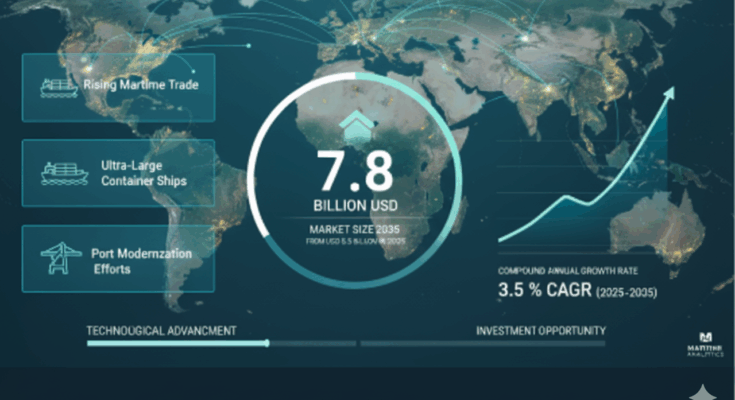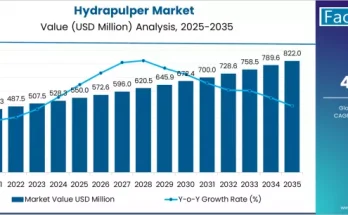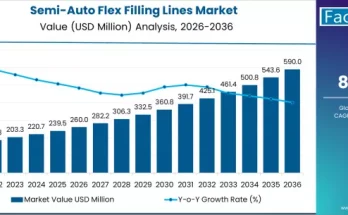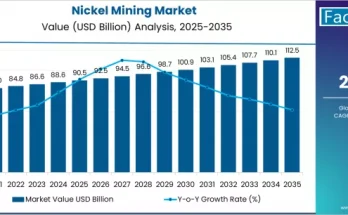Surging demand from construction, agriculture, and energy sectors positions hydraulic hose manufacturers for a decade of high-value growth.
The global hydraulic hose market is projected to grow from USD 12.2 billion in 2025 to USD 19.9 billion by 2035, reflecting a steady 5% compound annual growth rate (CAGR) over the forecast period. According to the latest analysis by Fact.MR, this expansion is powered by strong infrastructure investment, rising agricultural mechanization, and the integration of smart hydraulic technologies across key industries.
As economies worldwide prioritize large-scale infrastructure modernization and industrial automation, hydraulic hoses—critical components for fluid power transmission—are witnessing robust demand. These flexible, high-pressure conduits play a vital role in heavy machinery operations, construction equipment, mining systems, and advanced agricultural vehicles.
Infrastructure Expansion and Mechanized Agriculture Drive Market Momentum
The construction and infrastructure sectors continue to be the backbone of global hydraulic hose consumption. Urbanization in emerging economies such as India, China, and Brazil is fueling massive demand for heavy-duty machinery, including excavators, cranes, bulldozers, and loaders—each dependent on reliable hydraulic systems. The surge in government-backed smart city and transportation projects is further reinforcing this trend.
Simultaneously, mechanization in agriculture is accelerating the deployment of hydraulic hoses in tractors, harvesters, and irrigation systems. As the global food supply chain evolves to meet population growth and labor shortages, hydraulic-powered machinery is becoming indispensable to achieving productivity gains and operational efficiency. This is particularly evident in Asia-Pacific, where supportive government policies and subsidies are modernizing traditional farming practices.
In addition to construction and agriculture, mining and oil & gas industries are major demand generators. These sectors require high-performance hoses that can withstand extreme pressure, temperature, and abrasion. Hydraulic hoses are integral to drilling rigs, transport pipelines, and extraction equipment—particularly as energy exploration expands into deeper and harsher environments.
Technological Advancements Redefine Hose Performance
Modern hydraulic hoses are no longer just mechanical components—they are becoming smart, sustainable, and efficient power conduits. Continuous innovation in materials science is reshaping the market landscape. The introduction of thermoplastic hoses, multi-spiral reinforcements, and abrasion-resistant outer layers has enhanced product longevity and pressure-handling capacity.
The leading material segment—thermoplastics—is expected to capture around 34% of the market by 2025, driven by its lightweight design, chemical resistance, and flexibility. Thermoplastics are rapidly gaining adoption in robotics, automotive systems, and compact industrial machinery where space and mobility are key performance parameters.
At the same time, manufacturers are increasingly aligning product development with sustainability goals. Environmentally friendly and recyclable hoses are being designed to comply with stringent emission and safety regulations across North America and Europe. Companies investing in eco-conscious materials and low-leakage systems are positioning themselves as preferred partners in the evolving green manufacturing ecosystem.
Regional Trends Highlight Asia Pacific’s Leadership
Asia Pacific dominates the global hydraulic hose market and is forecasted to maintain the fastest growth trajectory through 2035. Countries like China and India lead the expansion due to extensive investments in industrial infrastructure, transportation networks, and renewable energy projects. The availability of low-cost manufacturing and favorable policies for local production are further amplifying the region’s competitive edge.
In North America, the U.S. market remains a hub of innovation and high-value demand. The Infrastructure Investment and Jobs Act (IIJA) has spurred massive upgrades to roads, bridges, and public utilities, directly stimulating the hydraulic equipment market. Additionally, the country’s shale gas and oil exploration activities continue to generate strong requirements for pressure-resistant and durable hoses.
Europe, driven by its advanced automotive and industrial base, exhibits steady demand supported by sustainability-focused manufacturing and the adoption of Industry 4.0 automation systems. Meanwhile, the Middle East and Africa are witnessing rising investments in mining and energy infrastructure, making them emerging frontiers for long-term growth.
Competitive Landscape: Innovation, Integration, and Sustainability at the Core
The hydraulic hose market is highly competitive, characterized by both global powerhouses and specialized regional manufacturers. Major players such as Bridgestone Corporation, Parker Hannifin Corporation, Eaton Corporation, Gates Corporation, Semperit AG, and Continental AG are leading through innovation and strategic expansion.
Recent developments underscore the sector’s dynamism. In January 2024, Continental announced a USD 90 million investment in a new hydraulic hose manufacturing facility in Aguascalientes, Mexico, significantly expanding its production capabilities in North America. Similar capacity expansions, strategic collaborations, and mergers are reshaping the global supply landscape.
Manufacturers are also focusing on IoT-enabled smart hoses equipped with sensors for real-time performance monitoring, predictive maintenance, and failure prevention. These intelligent systems help minimize downtime and optimize energy efficiency—key differentiators for industrial buyers seeking reliability and cost savings.
In addition, partnerships with OEMs in construction, agriculture, and mining are becoming increasingly common. These collaborations enable manufacturers to deliver integrated, customized hydraulic systems designed for specific operational challenges.
Challenges Ahead: Raw Material Volatility and Compliance Costs
Despite the strong outlook, the hydraulic hose industry faces challenges. Fluctuating prices of raw materials such as rubber, steel, and thermoplastics can pressure profit margins. Furthermore, stringent regulatory standards for safety, leakage prevention, and environmental performance necessitate continuous investment in testing, certification, and R&D.
Another emerging issue is the proliferation of low-cost counterfeit hoses, particularly in developing markets, which poses safety risks and threatens brand integrity. To counter this, global manufacturers are strengthening quality control, expanding certified dealer networks, and implementing traceability systems.
Outlook: Toward Smarter, Safer, and More Sustainable Fluid Power Systems
As industries transition toward automation and sustainability, hydraulic hose manufacturers stand at the forefront of innovation in mechanical power transmission. With strong multi-sectoral demand and rising technological sophistication, the next decade will be defined by smart, sustainable, and resilient hydraulic systems.
The global hydraulic hose market, projected to reach nearly USD 20 billion by 2035, represents not just industrial growth—but also an opportunity for manufacturers, investors, and OEMs to build the next generation of high-performance hydraulic ecosyste
Browse Full report : https://www.factmr.com/report/1257/harbor-deepening-market



